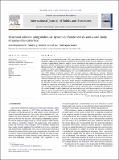Structural solution using molecular dynamics: Fundamentals and a case study of epoxy-silica interface
Author(s)
Buyukozturk, Oral; Buehler, Markus J.; Lau, Denvid; Tuakta, Chakrapan
DownloadBüyüköztürk-2011-Structural solution.pdf (1.731Mb)
PUBLISHER_POLICY
Publisher Policy
Article is made available in accordance with the publisher's policy and may be subject to US copyright law. Please refer to the publisher's site for terms of use.
Terms of use
Metadata
Show full item recordAbstract
In this paper, the molecular dynamics (MD) simulation technique is described in the context of structural mechanics applications, providing a fundamental understanding of the atomistic approach, and demonstrating its applicability. Atomistic models provide a bottom-up description of material properties and processes, and MD simulation is capable of solving the dynamic evolution of equilibrium and non-equilibrium processes. The applicability of the technique to structural engineering problems is demonstrated through an interface debonding problem in a multi-layered material system usually encountered in composite structures. Interface debonding may lead to a possible premature failure of fiber reinforced polymer (FRP) bonded reinforced concrete (RC) structural elements subjected to moisture. Existing knowledge on meso-scale fracture mechanics may not fully explain the weakening of the interface between concrete and epoxy, when the interface is under moisture; there is a need to study the moisture affected debonding of the interface using a more fundamental approach that incorporates chemistry in the description of materials. The results of the atomistic modeling presented in this paper show that the adhesive strength (in terms of energy) between epoxy and silica is weakened in the presence of water through its interaction with epoxy. This is correlated with the existing meso-scale experimental data. This example demonstrates that MD simulation can be effectively used in studying the durability of the system through an understanding of how materials interact with the environment at the molecular level. In view of the limitation of MD simulation on both length- and time-scales, future research may focus on the development of a bridging technique between MD and finite element modeling (FEM) to be able to correlate the results from the nano- to the macro-scale.
Date issued
2011-03Department
Massachusetts Institute of Technology. Department of Civil and Environmental EngineeringJournal
International Journal of Solids and Structures
Publisher
Elsevier
Citation
Buyukozturk, Oral, Markus J. Buehler, Denvid Lau, and Chakrapan Tuakta. “Structural Solution Using Molecular Dynamics: Fundamentals and a Case Study of Epoxy-Silica Interface.” International Journal of Solids and Structures 48, no. 14–15 (July 2011): 2131–2140. © 2011 Elsevier Ltd.
Version: Final published version
ISSN
00207683